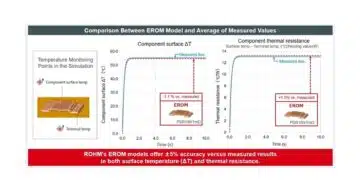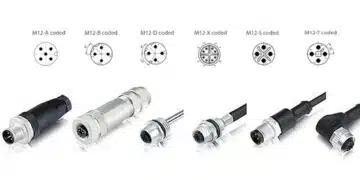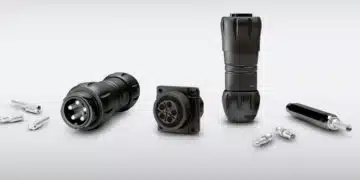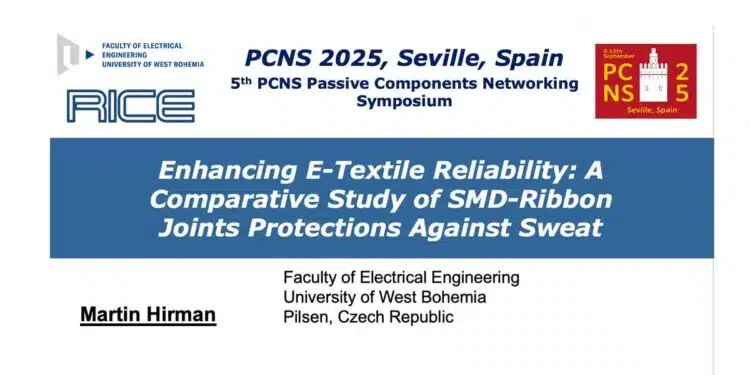The paper “Enhancing E-Textile Reliability: A Comparative Study of SMD-Ribbon Joints Protections Against Sweat” was presented by Martin Hirman, University of West Bohemia, Pilsen, Czech Republic at the 5th PCNS Passive Components Networking Symposium 9-12th September 2025, Seville, Spain as paper No. 2.1.
Introduction
The study investigates the durability and reliability of electronic textile (e-textile) systems in environments prone to sweat and humidity.
E-textiles integrate electronic components into flexible, wearable substrates, enabling applications in healthcare, sports performance monitoring, and safety systems. However, the interface between surface-mount device (SMD) components and conductive textile ribbons often represents a critical point of failure, particularly under exposure to mechanical stress, moisture, and chemical agents like sweat.
This study focuses on improving the reliability of SMD chip resistor joints on silver-coated copper microwire ribbons through two levels of protection: basic UV-curable adhesive encapsulation and additional seam-sealing textile adhesive tape.
Key Points
- Objective: Evaluate reliability of SMD-to-textile ribbon joints under accelerated aging with synthetic sweat.
- Methods: Comparison of basic encapsulation vs. additional seam-sealing adhesive tape protection.
- Testing: Four cycles of immersion in synthetic sweat, high-humidity aging, and drying; electrical resistance monitored using a four-point probe.
- Findings: Basic protection alone led to increasing resistance and failures; additional protection maintained low, stable resistance with no visible degradation.
- Conclusion: Seam-sealing adhesive tape significantly enhances the durability of e-textile connections.
Extended Summary
E-textiles represent a growing field where flexible fabrics are integrated with electronic functionality for applications ranging from wearable biosensors to military and sports monitoring systems. A key barrier to their long-term reliability is the environmental degradation of electrical connections, particularly when exposed to sweat, high humidity, and mechanical flexing. Passive components, such as SMD resistors, are essential to these systems, but the textile-component interface has been identified as a critical failure point.
In this study, researchers investigated the performance of SMD chip resistors attached to conductive textile ribbons using a specialized contacting technique. The conductive ribbons were made of stretchable silver-coated copper microwires. Two types of samples were prepared: one with basic UV-curable adhesive encapsulation, and one with additional seam-sealing textile adhesive tape to protect the joints and conductive paths. The contacting technique involved applying non-conductive UV-curable adhesive beneath the components, compressing the SMD leads against the conductive ribbon paths, curing the adhesive under pressure, and finally encapsulating the components.
The testing protocol simulated harsh environmental exposure: four cycles consisting of immersion in acidic synthetic sweat (pH 4.4) for 2 hours, high-humidity aging (40°C, 93% RH) for 164 hours, and drying at 40°C for 2 hours. Electrical resistance was measured after each cycle using a four-point probe method. Statistical analysis with bar charts and boxplots was used to evaluate trends in joint degradation.
Results showed a clear distinction between the two types of protection. Samples with only basic encapsulation exhibited a steady increase in electrical resistance, with several joints failing completely after the second aging cycle. Visible degradation, including damage to conductive paths, was observed during optical inspection. In contrast, samples with the additional seam-sealing adhesive tape maintained low and stable resistance values across all cycles. No visual or structural degradation was seen, even after destructive inspection of the ribbon’s internal structure.
These findings confirm that environmental stressors primarily affect the textile-electronic interface rather than the SMD components themselves. The additional seam-sealing tape effectively blocks sweat ingress, prevents mechanical wear, and substantially extends the operational life of e-textile connections.
Conclusion
The study demonstrates that robust protection of the textile-component interface is essential for the long-term reliability of e-textile systems, particularly in applications exposed to sweat and high humidity. The first hypothesis, that SMD-to-ribbon joints would maintain stable resistance under accelerated aging, was confirmed only for samples with additional seam-sealing protection. The second hypothesis, that seam-sealing tape enhances reliability, was fully validated. For practical deployment in sportswear, healthcare, and other demanding environments, incorporating seam-sealing adhesive tape with a UV-curable adhesive encapsulation provides a highly reliable solution for integrating SMD components into flexible textile substrates.
































